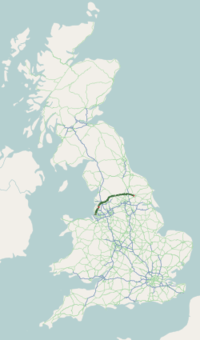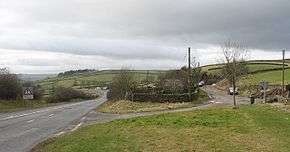A59 road
The A59 is a major road in England which runs from Wallasey, Merseyside to York, North Yorkshire.
Route
Merseyside
The A59 begins in Wallasey at the northern end of the M53 motorway, heading through the Kingsway Tunnel. In the centre of Liverpool, a separate 0.7 miles (1.1 km) spur heads north from the roundabout junction at the entrance of the Queensway Tunnel, first as Byrom Street, joining the main route at Scotland Road in Vauxhall. It continues north as Kirkdale Road, Walton Road and County Road, then as Rice Lane and to Walton Vale. It passes Aintree Racecourse as Warbreck Moor and Ormskirk Road (forming the boundary between Aintree and Netherton), before reaching the Switch Island junction, which is a large semi roundabout semi traffic light controlled junction, where the A5036, the M57, the M58 and the A59 all meet.
From the Switch Island junction the A59 travels through Maghull and Lydiate, into Lancashire through Aughton and thence to Ormskirk. This part of the road follows the same route as the Merseyrail Northern Line.
Lancashire
At Ormskirk, it reverts from a dual carriageway to single carriageway, on an old bypass. North of Ormskirk the A59 passes through Burscough and Rufford, before reaching the traffic light controlled crossroads at Tarleton, where the A565 joins. From here the road goes over the Leeds and Liverpool Canal and River Douglas via Bank Bridge then through Bretherton and Much Hoole before becoming the Longton (and Hutton) bypass, which is a dual carriageway route.
The road passes the Lancashire Police HQ, before going through Penwortham as Liverpool Road and across the River Ribble into Preston. It bypasses the city centre via Ring Way, where the A583 from Blackpool joins the road at a crossroads. It briefly merges with the A6, and then heads east out of the centre as New Hall Lane. It meets the M6 at junction 31 between Lower Brockholes and Samlesbury. After this junction, the road splits into two separate carriageways until it meets the A677 for Blackburn.
The A59 then goes through Myerscough Smithy, veers left, and runs around the perimeter of Samlesbury Aerodrome (a British Aerospace installation). As Longsight Road, it then goes through Mellor, Osbaldeston, Copster Green and Langho, where it meets the A666. From this point it bypasses Billington, Whalley, Clitheroe and Chatburn.
After Chatburn the road goes past Sawley before going through the village of Gisburn.
Yorkshire
From Horton it enters North Yorkshire and goes through West and East Marton before a roundabout junction with the A56 after which the road passes Broughton. After passing through Broughton, the road meets the Skipton bypass at its western end, where it overlaps the A65 on its route between Kendal and Leeds. Skipton bypass was opened in 1981, providing welcome relief to the town, which often became a bottleneck as through traffic crossed in the town. The concurrent bypass crosses the B6265 north of the town, and then de-merges with the A65 to the east of the town.
The A59 was upgraded to primary status during the 1990s due to its increased perceived importance as an east-west route. It then passes over the Embsay and Bolton Abbey Steam Railway through a roundabout junction with the B6260 before rising up Beamsley hill, which was two lanes eastbound (uphill) and a single lane westbound during the incline - which was improved at various points during the 1980s. At the top of the hill, the road crosses into the Harrogate district. At this point, there is a long narrow descent on the edge of a huge ravine, down to the village of Blubberhouses.
The A59 then runs along the head of Fewston Reservoir and follows the route of a Roman road past the 'golf balls' at Menwith Hill, an RAF station. As Skipton Road the A59 then declines towards Harrogate passing Kettlesing, and the Knabbs Ridge wind farm. Once it reaches Harrogate, still as Skipton Road it first acts as the northern perimeter of a large housing estate, before meeting the A61 Ripon Road for Ripon, Harrogate town centre and Leeds. The A59 then continues through the suburbs of the town as Skipton Road, avoiding the centre. This is largely due to the history of the town - Harrogate's centre was traditionally known as 'Low Harrogate', whilst the A59 travels through 'High Harrogate'. This stretch of the route is claimed to be the busiest road in North Yorkshire. Part of this section travels across the Stray, an act-protected tract of grassy land which horseshoes around the town centre. The A59 then turns left at the Empress Roundabout, which is itself on the Stray, towards Starbeck, as Knaresborough Road- although traffic travelling towards York is directed onto the A661 Wetherby Road to utilise the Harrogate and Knaresborough Southern Bypass (A658). The A59, however, continues to travel through Starbeck as Knaresborough Road and later High Street, then heads east to Knaresborough. It passes through the centre of Knaresborough, and as it heads toward York becomes York Road.
The remainder of the route is comparatively flat. From Knaresborough the A59 meets up with York-directed traffic from Harrogate on the A658, and skirts to the north of Goldsborough towards the A1(M). Originally the route went through the village of Flaxby and onto Allerton, but the route now travels a stricted east-west route and meets the A1(M) at its junction 47. The road then passes to the south of Green Hammerton. Originally it ended here, with the A66 routed down from Boroughbridge and going into York. Now the A59 itself heads towards York, travelling close to such places as Nun Monkton, Upper Poppleton and Moor Monkton before finally ending just to the west of the city walls at a zebra crossing at the junction of Bishopthorpe Road and Nunnery Lane which is the A1036.
Road safety
The A59 has persistently featured in the top 10 most dangerous roads in Britain.[1] In 2008 European Road Assessment Programme reported the risk of being involved in a death or disabling injury accident as being between Low-medium and Medium-high depending on the section of road travelled.[2]
In 2004 The Times reported on the lives of those who have lost loved ones on this road.[3]
See also
References
- ↑ "How Safe Are Britain's Main Roads?" (PDF). The AA Motoring Trust. 31 May 2006. Archived from the original (PDF) on 26 July 2011. Retrieved 23 November 2016.
- ↑ "Search Results - GB A59 (Risk Rate)". EuroRAP. Archived from the original on 26 July 2011. Retrieved 23 November 2016.
- ↑ Webster, Ben (15 June 2004). "Britain's most dangerous road"
 . The Times. London: News International. ISSN 0140-0460. Retrieved 8 November 2015.
. The Times. London: News International. ISSN 0140-0460. Retrieved 8 November 2015.
External links
Coordinates: 53°56′32″N 2°13′17″W / 53.94235°N 2.22132°W


